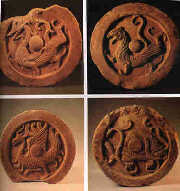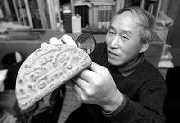 The Wadang (eaves tile in English) is a treasured symbol in China's millenniums-old field of architecture, with a rich and mystic cultural connotation.
The Wadang (eaves tile in English) is a treasured symbol in China's millenniums-old field of architecture, with a rich and mystic cultural connotation.
Last week, the unveiling of the abundant tiles collected by Guan Zengzhu, an amateur wadang collector, and the publication of his A Textual Research on Pre-Qin and Han Wadang Decorations excited the architectural circle by decoding some historical doubts and suspicions concerning wadangs.
 An amateur and his 400 treasured tiles
An amateur and his 400 treasured tiles

Guan's book, prefaced by Luo Zhewen, a senior expert on ancient architecture protection, not only dwells at great length on the evolution of thewadangculture (as well as its history, rich designs, and great varieties), but also elaborately analyzes the connections between the wadang culture and historic events, social etiquette, hierarchical ranking, and some historic figures.
Although Guan Zengzhu, a retired publishing house editor, has no architectural or historical background, what he does have is an infatuated passion for the collection of antiques and porcelains. The convincing material evidences, accurate illustrations, and scientific methodology used in his book have won recognition from historians and experts alike.
After reading the book, Shi Shuqing, the connoisseur of cultural relics inNational Museum of China, not only wrote a poem dedicated to the book's cover story, but also without hesitation presented Guan a wadang rubbing of theHan Dynasty(206BC-220AD), which had been part of Shi's own collection since being excavated fromXi'anof North China'sShaanxi Provinceseveral years ago.
Guan's devotion to wadangs continues to grow, day by day. In the last seven years, he has collected almost 400 wadang pieces of various designs, craftwork, and calligraphic styles of zhuan (sealscript). All his bookshelves, even the top of his closet, are occupied by rows of orderly lined-up wadangs.
Chinese ancient architecture is the soul of the world art, and the wadang has been considered as the soul ofChinese architecture, said Guan, unconsciously brimming with pride.
 Evolution of the wadang culture
Evolution of the wadang culture
 Rooftiles, or wa in Chinese, appeared as early as in theXia Dynasty(2100-1600BC), serving to protect inhabitants from weather hazards and intruders. Its calligraphic style ofxiaozhuan(lessersealscript) ( ) vividly portrays the tiles: laid one over another and joined together by lime in alternating and curved rows, concave and convex, on the roof.
Rooftiles, or wa in Chinese, appeared as early as in theXia Dynasty(2100-1600BC), serving to protect inhabitants from weather hazards and intruders. Its calligraphic style ofxiaozhuan(lessersealscript) ( ) vividly portrays the tiles: laid one over another and joined together by lime in alternating and curved rows, concave and convex, on the roof.
The first tile in each row of the roof tiles is called awadang, since dang in archaic Chinese means the "end." The first tiles are usually placed underneath each row and all the way along the eaves of the sloping roof, hence the English name oftile-endsor eaves tiles. The wadang is an important component and ornament of traditionalChinese architecture, with both protective and decorative functions.
Wadangs adorned with molded designs can be cast back to the WesternZhou Dynasty(1100-771BC), but the use of stylized characters as architectural ornaments appeared in the State of Yan during theWarring States Period(475-221BC). The tradition flourished during the Qin (221-206BC) and Han (206BC-220AD) dynasties, and is therefore known as "Qin brick and Han tile."
Wadangs of theQin Dynastywere commonly decorated with patterns of animals, most particularly the deer. The Chinese word for deer is lu, which is similar in pronunciation to that for wealth. The deer was hence a common decorative motif during the Qin Period. In theHan Dynasty, the technique of making wadangs reached its peak. The designs were elaborate and wadangs decorated with zhuan (seal script), especially xiaozhuan (lesser seal script), came into being.
